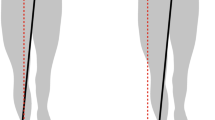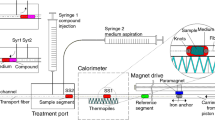Summary
The use of the locust (Schistocerca americana) hindleg in postural control was examined in animals that stood on a repeatedly swayed vertical substrate. Myograms were recorded from leg muscles and the angle of the femoro-tibial joint was monitored photographically. Two discrete strategies were observed,; in compensatory reactions the hindleg was held in place, while in “flexion” reactions, the leg was moved, most often to complete flexion of the femoro-tibial joint. Tightly coupled, rhythmic bursting occurred in the flexor and levator muscles of the leg during compensatory reactions. Bursting was initiated repeatedly when the substrate was being pulled away from the animal. Bursting was correlated with subsequent decreases in the rate of change of the femorotibial joint angle. Compensatory and “flexion” reactions occurred preferentially in different ranges of joint angles: most often, compensatory reactions occurred in the midrange, while “flexion” reactions were elicited in the extremes of joint angle. These differences may be due to the mechanical advantages of the tibial muscles and the leg may be moved to full flexion because of a locking mechanism of the flexor muscle tendon. These reactions are compared with known reflexes of hindleg proprioceptors and contrasted with similar responses of vertebrates.
Similar content being viewed by others
References
Barnes WJ, Spirito CP, Evoy WH (1972) Nervous control of walking in the crab, Cardisoma guanhumi. II. Role of resistance reflexes in walking. Z Vergl Physiol 76:16–31
Bässler U, Büschges A (1990) Interneurones participating in the “active reaction” in stick insects. Biol Cybern 62:529–538
Burrows M (1988) Responses of spiking local interneurons in the locust to proprioceptive signals from the femoral chordotonal organ. J Comp Physiol A 164:207–217
Burrows M, Pflüger HJ (1986) Processing by local interneurons of mechanosensory signals involved in a leg reflex of the locust. J Neurosci 6:2764–2777
Burrows M, Laurent GJ, Field LH (1988) Proprioceptive inputs to nonspiking local interneurons contribute to local reflexes of a locust hindleg. J Neurosci 8:3085–3093
Büschges A (1989) Processing of sensory input from the femoral chordotonal organ by spiking interneurons in stick insects. J Exp Biol 144:81–111
Büschges A (1990) Nonspiking pathways in a joint-control loop of the stick insect Carausius morosus. J Exp Biol 151:133–160
Chandler JM, Duncan PW, Studenski SA (1990) Balance performance on the postural stress test: Comparison of young adults, healthy elderly, and fallers. Phys Ther 70:410–415
Chasserat C, Clarac F (1983) Quantitative analysis of walking in a decapod crustacean, the rock lobster Jasus lalandii II. Spatial and temporal regulation of stepping in driven walking. J Exp Biol 107:219–243
Cohen H, Keshner EA (1988) Current concepts of the vestibular system reviewed: 2. Visual/vestibular interaction and spatial orientation. Am J Occupat Ther 43:331–337
Debrodt B, Bässler U (1990) Responses of flexor motor neurones to stimulation of the femoral chordotonal organ of the phasmid, Extatosoma tiaratum. Zool Jb Physiol 94:101–119
Dietz V, Quintern J, Berger W (1984) Corrective reactions to stumbling in man: functional significance of spinal and transcortical reflexes. Neurosci Letters 44:131–135
Dietz V, Quintern J, Berger W (1986) Stumbling reactions in man: release of a ballistic movement pattern. Brain Res 362:355–357
Dietz V, Quintern J, Sillem J (1987) Stumbling reactions in man: significance of proprioceptive and pre-programmed mechanisms. J Physiol 386:149–163
Do MC, Breniere Y, Brenguier P (1982) A biomechanical study of balance recovery during the fall forward. J Biomechanics 15:933–939
Duncan PW, Studenski S, Chandler J, Bloomfeld R, LaPointe LK (1990) Electromyographic analysis of postural adjustments in two methods of balance testing. Phys Ther 70:88–96
Field LH, Burrows M (1982) Reflex effects of the femoral chordotonal organ upon leg motor neurones of the locust. J Exp Biol 101:265–285
Forman RR, Zill SN (1984) Leg position learning by an insect. II. Motor strategies underlying learned leg extension. J Neurobiol 15:221–237
Forssberg H (1979) Stumbling corrective reaction: a phase dependent compensatory reaction during locomotion. J Neurophysiol 42:936–953
Heitler WJ (1974) The locust jump: specializations of the metathoracic femoral-tibial joint. J Comp Physiol 89:93–104
Heitler WJ, Burrows M (1977a) The locust jump. I. The motor programme. J Exp Biol 66:203–219
Heitler WJ, Burrows M (1977b) The locust jump. II. Neural circuits of the motor programme. J Exp Biol 66:221–241
Hoyle G (1978) Intrinsic rhythm and basic tonus in insect skeletal muscle. J Exp Biol 73:173–203
Hoyle G (1983) Muscles and their neural control. John Wiley and Sons, New York
Keshner EA, Cohen H (1988) Current concepts of the vestibular system reviewed: 1. The role of the vestibulospinal system in postural control. Am J Occupat Ther 43:320–330
Keshner EA, Woollacott MH, Debu B (1988) Neck, trunk and limb responses during postural perturbations in humans. Exp Brain Res 71:455–466
Macpherson JM (1988) Strategies that simplify the control of quadrupedal stance. I. Forces on the ground. J Neurophysiol 60:204–217
Markl H (1971) Proprioceptive gravity perception in Hymenoptera. In: Gordon SA, Cohen MJ (eds) Gravity and the organism. University of Chicago Press, Chicago, pp 185–194
Matheson T (1990) Responses and locations of neurones in the locust metathoracic femoral chordotonal organ. J Comp Physiol A 166:915–927
Matheson T, Field LH (1990) Innervation of the metathoracic femoral chordotonal organ of Locusta migratoria. Cell Tissue Res 259:551–560
Nashner LM (1976) Adapting reflexes controlling the human posture. Exp Brain Res 26:59–72
Nashner LM (1977) Fixed patterns of rapid postural responses among leg muscles during stance. Exp Brain Res 30:13–24
Nashner LM, McCollum G (1985) The organization of human postural movements: a formal basis and experimental synthesis. Behav Brain Sci 8:135–172
Nashner LM, Woollacott M, Tuma G (1979) Organization of rapid responses to postural and locomotor-like perturbations of standing man. Exp Brain Res 36:464–476
Neil DM (1975) The mechanism of statocyst operation in the mysid shrimp, Praunus flexuosus. J Exp Biol 62:505–518
O'Shea M, Evans PD (1979) Potentiation of neuromuscular transmission by an octopaminergic neurone in the locust. J Exp Biol 79:169–190
Pflüger HJ (1980) The function of hair sensilla on the locust's leg: the role of tibial hairs. J Exp Biol 87:163–175
Phillips CE (1980) An arthropod muscle innervated by nine excitatory motor neurons. J Exp Biol 88:249–258
Piek T, Van Marle J, Mantel P, Lind A (1979) Peripheral control of basic tonus and myogenic rhythm in the extensor tibiae of Schistocerca gregaria. Comp Biochem Physiol 64A:565–569
Usherwood PNR, Runion HI, Campbell JI (1968) Structure and physiology of a chordotonal organ in the locust leg. J Exp Biol 48:305–323
Wendler G (1971) Gravity orientation in insects: the role of different mechanoreceptors. In: Gordon SA, Cohen MJ (eds) Gravity and the organism. University of Chicago Press, Chicago, pp 195–201
Wilson DM, Larimer JL (1968) The catch property of ordinary muscle. Proc Natl Acad Sci USA 61:909–916
Wolfson LI, Whipple R, Amerman P, Kleinberg A (1986) Stressing the postural response: A quantitative method for testing balance. J Am Ger Soc 34:845–850
Yox DP, DiCaprio RA, Fourtner CP (1982) Resting tension and posture in arthropods. J Exp Biol 96:421–423
Zill SN (1985a) Plasticity and proprioception in insects. I. Responses and cellular properties of the locust metathoracic femoral chordotonal organ. J Exp Biol 116:435–461
Zill SN (1985b) Plasticity and proprioception in insects. II. Modes of reflex action of the locust metathoracic femoral chordotonal organ. J Exp Biol 116:463–480
Zill SN, Frazier SF (1990a) Responses of locusts in a paradigm which tests postural load compensatory reactions. Brain Res 535:1–8
Zill SN, Frazier SF (1990b) Range fractionation in responses of spiking interneurons that detect joint movement in locusts. Neurosci Abstr 16, Part 1, p 117
Zill SN, Jepson-Innes KA (1988) Evolutionary adaptation of a reflex system: sensory hysteresis counters muscle “catch” tension. J Comp Physiol A 164:43–48
Zill SN, Jepson-Innes KA (1990) Functions of a proprioceptive sense organ in freely moving insects: characteristics of reflexes elicited by stimulation of the locust metathoracic femoral chordotonal organ. Brain Res 523:211–218
Author information
Authors and Affiliations
Rights and permissions
About this article
Cite this article
Zill, S.N., Frazier, S.F., Lankenau, J. et al. Characteristics of dynamic postural reactions in the locust hindleg. J Comp Physiol A 170, 761–772 (1992). https://doi.org/10.1007/BF00198987
Accepted:
Issue Date:
DOI: https://doi.org/10.1007/BF00198987




